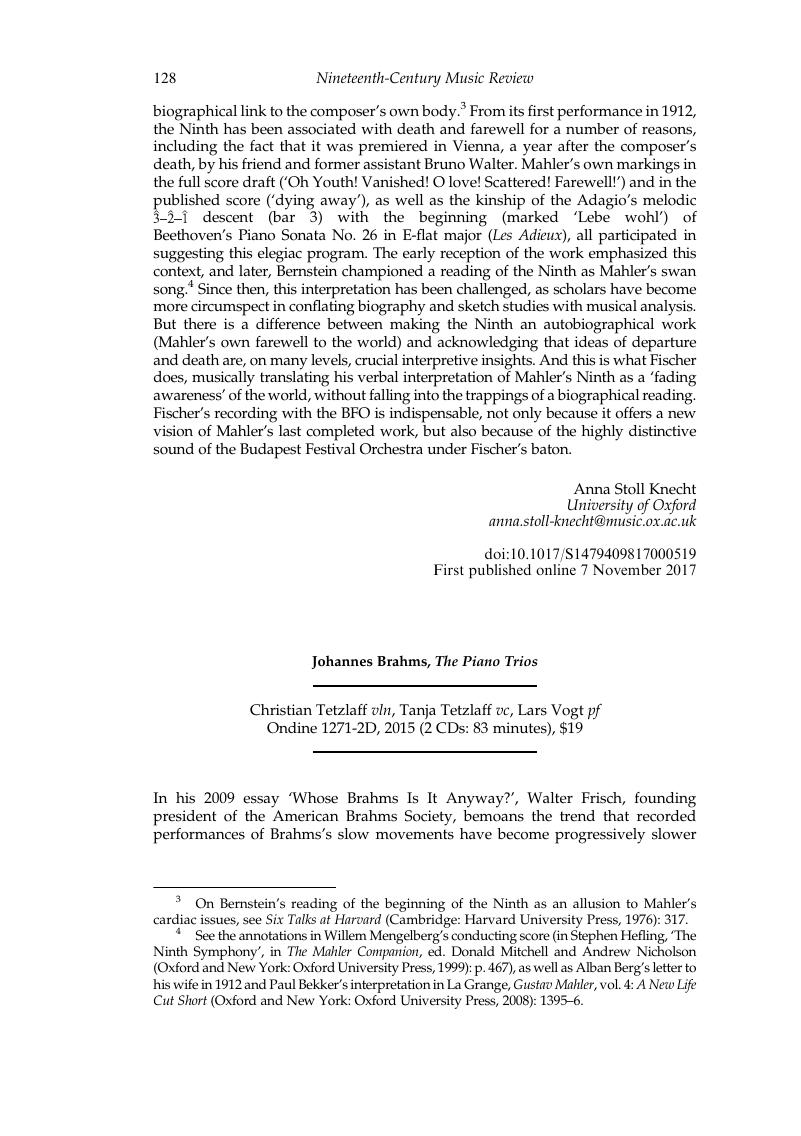No CrossRef data available.
Article contents
Johannes Brahms, The Piano Trios Christian Tetzlaff vln, Tanja Tetzlaff vc, Lars Vogt pf Ondine 1271-2D, 2015 (2 CDs: 83 minutes), $19
Review products
Published online by Cambridge University Press: 05 December 2017
Abstract

- Type
- CD Reviews
- Information
- Copyright
- © Cambridge University Press 2017
References
1 Frisch, Walter, ‘Whose Brahms Is It Anyway? Observations on the Recorded Legacy of the B♭ Piano Concerto, Op. 83’, in Musical Meaning and Human Values, ed. Keith Chapin and Lawrence Kramer (New York: Fordham University Press, 2009): 102–115 CrossRefGoogle Scholar.
2 Frisch, ‘Whose Brahms Is It Anyway?’, 110.
3 Hans von Bülow coins the expression ‘glüberisch Brahms’ to belittle the young composer’s piano playing before the two develop a close friendship. See Michael Musgrave’s discussion in A Brahms Reader (New Haven: Yale University Press, 2000): 127. As Walter Frisch points out, Brahms himself probably deplored the expression, and had once applied it to a performance of his first symphony by Hans Richter, which he criticized as dull and grey. See Frisch, , ‘In Search of Brahms’s First Symphony: Steinbach, the Meiningen Tradition, and the Recordings of Hermann Abendroth’, in Performing Brahms: Early Evidence of Performance Style, ed. Michael Musgrave and Bernard D. Sherman (Cambridge: Cambridge University Press, 2003): 280 Google Scholar.
4 Berry, Wallace, Musical Structure and Performance (New Haven: Yale University Press, 1989): 3 CrossRefGoogle Scholar. Berry defines articulation as ‘the calculated control of the discrete musical impulse itself, in an infinite range of possibilities. Here are included all tempering adjustments of individual events: in intensity, in duration, in consistencies of legato by which events may in one sense be grouped, and in punctuations by which they are, however slightly, separated. Like the choice of tempo articulation often suggests expressive character, especially in its broad tendencies but also in modulations of the surface’.
5 For instance, in bars 5ff of the opening movement of Piano Trio in B major op. 8, many performances put the right hand of the piano on equal footing with the cello, especially bringing out the F♯–B motion in bars 8–9 – a reference to the opening gesture in bar 1 – to emphasize motivic economy and the dialogic effect between the two instruments. The premium put on clarifying organic relationships inevitably engenders a thicker sound than that of Tanja Tetzlaff and Lars Vogt, in which the cello unequivocally carries the melody while the piano recedes to the background.
6 Jeremy Eichler, ‘String Theorist: Christian Tetzlaff Rethinks How a Violin Should Sound’, New Yorker 27 August 2012.
7 Tetzlaff’s shaping of the two-bar segments is illustrative of Hugo Riemann’s concept of dynamic shading (dynamische Schattierung), which prescribes a paradigm of crescendo (a becoming) followed by a descrescendo (a dying off) for basic melodic motives. See Riemann, , Musikalische Dynamik und Agogik (Hamburg: D. Rahter, 1884)Google Scholar. For a detailed critique of Riemann’s dynamic shading as a metrical and performance theory, see William Caplin, ‘Theories of Harmonic-Metric Relationships from Rameau to Riemann’ (PhD diss., University of Chicago, 1981); and ‘Riemann’s Theory of Dynamic Shading: A Theory of Meter?’ Theoria 1 (1985): 1–24.
8 Compare, for instance, with the treatment of the same passage in Brahms: Sextet No. 1 and Piano Trio No. 1, performed by Isaac Stern, Pablo Casals and Myra Hess, Sony Classical 01-058994-10, 1993 (CD). Stern, et al., approach the cadence in G-sharp minor with dramatic intensification of tone and broadening of tempo.
9 Andrew Clements, review of Robert Schumann, Complete Works for Piano Trio, performed by Leif Ove Andsnes, Christian Tetzlaff and Tanja Tetzlaff, EMI Classics 0941802, 2011 (CD), in The Guardian, 19 May 2011.
10 Cook, Nicholas, ‘Performing Rewriting and Rewriting Performance: The First Movement of Brahms’s Piano Trio, Op. 8’, Dutch Journal of Music Theory 4/3 (1999): 227–234 Google Scholar.
11 Cook, , ‘Performing Rewriting and Rewriting Performance’, 232 Google Scholar.
12 Speaking in Eichler, ‘String Theorist’.





